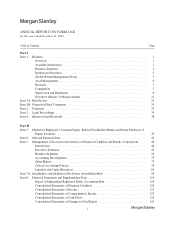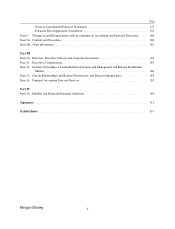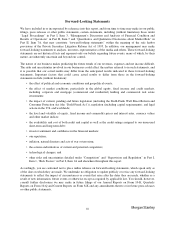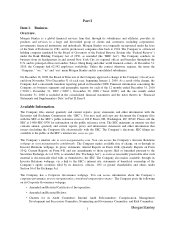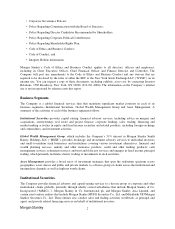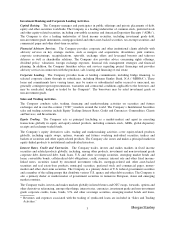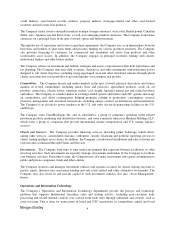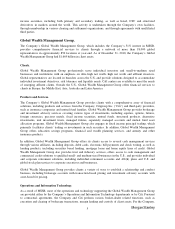Morgan Stanley 2010 Annual Report Download - page 13
Download and view the complete annual report
Please find page 13 of the 2010 Morgan Stanley annual report below. You can navigate through the pages in the report by either clicking on the pages listed below, or by using the keyword search tool below to find specific information within the annual report.
behalf of institutional, intermediary and high net worth clients. These activities are undertaken through the
Company’s own facilities, through membership in various clearing and settlement organizations, and through
agreements with unaffiliated third parties.
Research.
The Company’s research department (“Research”) coordinates globally across all of the Company’s businesses.
Research consists of economists, strategists and industry analysts who engage in equity and fixed income
research activities and produce reports and studies on the U.S. and global economy, financial markets, portfolio
strategy, technical market analyses, individual companies and industry developments. Research examines
worldwide trends covering numerous industries and individual companies, the majority of which are located
outside the U.S.; provides analysis and forecasts relating to economic and monetary developments that affect
matters such as interest rates, foreign currencies, securities, derivatives and economic trends; and provides
analytical support and publishes reports on asset-backed securities and the markets in which such securities are
traded and data are disseminated to investors through third-party distributors, proprietary internet sites such as
Client Link and the Company’s sales forces.
Competition.
All aspects of the Company’s businesses are highly competitive, and the Company expects them to remain so.
The Company competes in the U.S. and globally for clients, market share and human talent in all aspects of its
business segments. The Company’s competitive position depends on its reputation and the quality and
consistency of its long-term investment performance. The Company’s ability to sustain or improve its
competitive position also depends substantially on its ability to continue to attract and retain highly qualified
employees while managing compensation and other costs. The Company competes with commercial banks,
brokerage firms, insurance companies, sponsors of mutual funds, hedge funds, energy companies and other
companies offering financial services in the U.S., globally and through the internet. Over time, certain sectors of
the financial services industry have become more concentrated, as institutions involved in a broad range of
financial services have been acquired by or merged into other firms or have declared bankruptcy. Such changes
could result in the Company’s remaining competitors gaining greater capital and other resources, such as the
ability to offer a broader range of products and services and geographic diversity. See also “Supervision and
Regulation” and “Risk Factors” herein.
Institutional Securities and Global Wealth Management Group.
The Company’s competitive position depends on innovation, execution capability and relative pricing. The
Company competes directly in the U.S. and globally with other securities and financial services firms and broker-
dealers and with others on a regional or product basis.
The Company’s ability to access capital at competitive rates (which is generally dependent on the Company’s
credit ratings) and to commit capital efficiently, particularly in its capital-intensive underwriting and sales,
trading, financing and market-making activities, also affects its competitive position. Corporate clients may
request that the Company provide loans or lending commitments in connection with certain investment banking
activities, and such requests are expected to increase in the future.
It is possible that competition may become even more intense as the Company continues to compete with
financial institutions that may be larger, or better capitalized, or may have a stronger local presence and longer
operating history in certain areas. Many of these firms have greater capital than the Company and have the ability
to offer a wide range of products and services that may enhance their competitive position and could result in
pricing pressure in our businesses. The complementary trends in the financial services industry of consolidation
and globalization present, among other things, technological, risk management, regulatory and other
infrastructure challenges that require effective resource allocation in order for the Company to remain
competitive.
7


